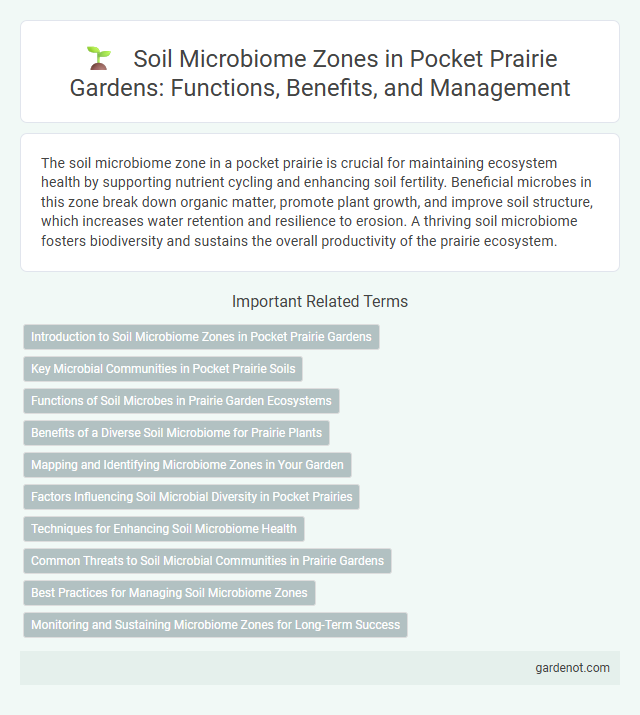The soil microbiome zone in a pocket prairie is crucial for maintaining ecosystem health by supporting nutrient cycling and enhancing soil fertility. Beneficial microbes in this zone break down organic matter, promote plant growth, and improve soil structure, which increases water retention and resilience to erosion. A thriving soil microbiome fosters biodiversity and sustains the overall productivity of the prairie ecosystem.
Introduction to Soil Microbiome Zones in Pocket Prairie Gardens
Soil microbiome zones in Pocket Prairie gardens are distinct areas where diverse microbial communities interact with plant roots and organic matter, influencing soil health and nutrient cycling. These zones, characterized by unique compositions of bacteria, fungi, and other microorganisms, play a crucial role in enhancing soil fertility and promoting plant growth. Understanding the structure and function of these microbial zones enables more effective management of Pocket Prairie ecosystems for sustainable agriculture and biodiversity conservation.
Key Microbial Communities in Pocket Prairie Soils
Key microbial communities in pocket prairie soils include nitrogen-fixing bacteria such as Rhizobium and Azotobacter, which enhance soil fertility by converting atmospheric nitrogen into bioavailable forms. Mycorrhizal fungi, including arbuscular mycorrhizal species, establish symbiotic relationships with prairie plant roots, improving nutrient uptake and soil structure. These microbial consortia drive essential biogeochemical cycles, supporting plant health and ecosystem resilience in pocket prairie environments.
Functions of Soil Microbes in Prairie Garden Ecosystems
Soil microbes in Pocket Prairie ecosystems play a crucial role in nutrient cycling by breaking down organic matter and releasing essential nutrients like nitrogen and phosphorus, which promote plant growth. These microbes enhance soil structure and water retention through the production of biofilms and extracellular polymers, improving ecosystem resilience. Additionally, soil microbiomes contribute to disease suppression by outcompeting harmful pathogens, fostering a healthy and balanced prairie garden environment.
Benefits of a Diverse Soil Microbiome for Prairie Plants
A diverse soil microbiome in pocket prairies enhances nutrient cycling, improves soil structure, and supports plant health by increasing resistance to pathogens. Beneficial microbes, including mycorrhizal fungi and nitrogen-fixing bacteria, promote root growth and nutrient uptake, resulting in more resilient prairie vegetation. This microbial diversity also fosters ecosystem stability and boosts the productivity of native prairie plants.
Mapping and Identifying Microbiome Zones in Your Garden
Mapping and identifying soil microbiome zones in your pocket prairie reveals diverse microbial communities essential for plant health and nutrient cycling. Using soil sampling and DNA sequencing techniques helps pinpoint distinct microbiome hotspots, optimizing zones for native plant growth and disease resistance. Understanding these zones enables targeted management practices that enhance soil fertility and biodiversity in your garden ecosystem.
Factors Influencing Soil Microbial Diversity in Pocket Prairies
Soil microbial diversity in pocket prairies is influenced by factors such as soil pH, organic matter content, moisture levels, and plant species composition. High organic matter and diverse plant roots create niches that support a wide range of bacteria, fungi, and archaea, enhancing nutrient cycling and soil health. Microbial interactions driven by soil texture and microclimate conditions also play a critical role in maintaining functional biodiversity within these small-scale ecosystems.
Techniques for Enhancing Soil Microbiome Health
Techniques for enhancing soil microbiome health in pocket prairies include biochar application, which improves microbial habitat and nutrient retention. Introducing diverse plant species promotes root exudate variety, fostering microbial diversity and activity. Soil amendments such as compost and organic mulches boost beneficial microbial populations, enhancing nutrient cycling and soil structure.
Common Threats to Soil Microbial Communities in Prairie Gardens
Common threats to soil microbial communities in pocket prairie gardens include soil compaction, pesticide use, and nutrient depletion. Soil compaction reduces pore space, limiting oxygen availability and impairing microbial activity essential for nutrient cycling. Pesticides can disrupt microbial diversity by targeting non-target beneficial microbes, while nutrient depletion from imbalanced fertilization hampers microbial growth and ecosystem resilience.
Best Practices for Managing Soil Microbiome Zones
Effective management of soil microbiome zones in pocket prairies involves maintaining diverse plant species to promote microbial diversity and enhance nutrient cycling. Applying organic mulches and minimizing chemical inputs supports beneficial microorganisms while improving soil structure and moisture retention. Regular soil testing guides targeted amendments that optimize microbial activity and overall soil health.
Monitoring and Sustaining Microbiome Zones for Long-Term Success
Monitoring soil microbiome zones in pocket prairies involves tracking microbial diversity and activity to ensure ecosystem stability and nutrient cycling. Employing metagenomic sequencing and soil enzyme assays provides detailed insights into microbial community composition and function, enabling targeted interventions. Sustaining these microbiome zones requires maintaining organic matter inputs and minimizing soil disturbance to support microbial resilience and long-term prairie health.
Soil microbiome zone Infographic

 gardenot.com
gardenot.com